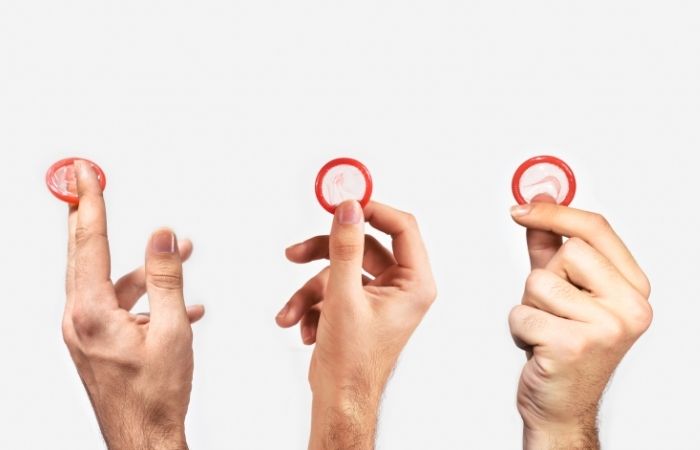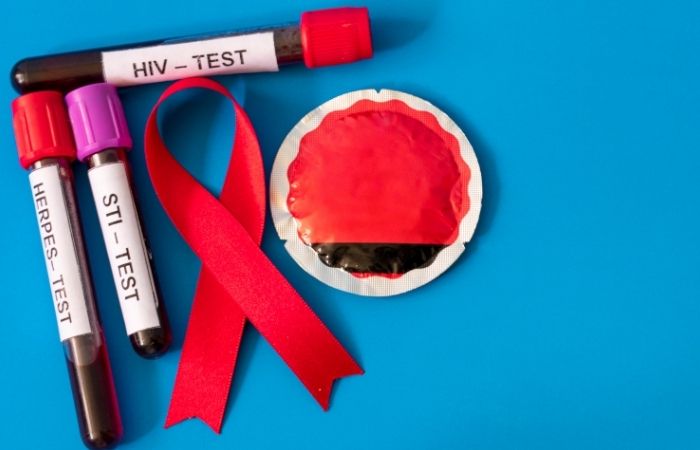Can You Have a Healthy Sex Life With Herpes or HIV? Yes, Here’s How
Here we demystify the most outrageous and ridiculous sexually transmitted disease (STD) myths still believed by people today. To help you and the people around you stay safe, we’ll set the record straight based on facts derived from studies in science and real-life events.
Now let's get started.

Myth #1: A Toilet Seat Can Spread Sexually Transmitted Diseases
One of the most common and persistent myths is that STDs can live on toilet seats and infect the next person who sits down. Sounds plausible, right? It’s not.
The Verdict
This one’s dead wrong. STDs are transmitted through direct skin-to-skin contact or body fluids—not cold, hard surfaces. Bacteria and viruses like chlamydia, gonorrhea, and syphilis don’t survive long outside the body, especially on something like a toilet seat.
What We Know
A study in the Journal of Infectious Diseases confirms that STI pathogens die quickly once outside the body. The CDC has never recorded a single case of someone contracting an STD from a toilet seat. It’s a myth, plain and simple.
Real-Life Example
In 2017, a woman in Florida sued a hotel, claiming she got herpes from a dirty toilet seat. Doctors shut it down fast. Herpes simplex virus (HSV) can only spread through direct skin contact—there’s no scientific support for transmission via toilet seats.

Second Myth: Sexually Transmitted Diseases Can Exist Without Symptoms
A lot of people assume they’re in the clear if they don’t have symptoms—but that’s a dangerous misunderstanding.
The Verdict
Most STDs don’t show symptoms right away, and some never do. You can go months or even years carrying an infection without realizing it.
What We Know
According to the World Health Organization (WHO), most people with chlamydia or gonorrhea are asymptomatic. Infections like genital herpes and HPV may take years to show signs—or stay invisible altogether.
Real-Life Example
Emily, 26, had zero symptoms when she tested positive for chlamydia during a routine checkup. Her doctor explained the infection could’ve silently damaged her reproductive system if left untreated. No symptoms doesn’t mean no infection.
Bottom line? No symptoms doesn’t mean you’re safe. Get tested regularly.
Check Your STD Status in Minutes
Test at Home with Remedium7-in-1 STD Test Kit

 For Men & Women
For Men & Women Results in Minutes
Results in Minutes No Lab Needed
No Lab Needed Private & Discreet
Private & DiscreetOrder Now $129.00 $343.00
For all 7 tests
Third Myth: Oral or Anal Sex Won't Infect You With a Sexually Transmitted Disease
This is a potentially deadly fallacy that many people have, as it's often believed that STDs are transmitted only by vaginal sex.
The Verdict
Even without the involvement of fluids, oral and anal sex can transmit a variety of sexually transmitted diseases (STDs), from herpes to gonorrhea, syphilis, and HPV.
What We Know
Oral sex is a leading mode of transmission of gonorrhea and human papillomavirus (HPV), according to the Journal of Sexually Transmitted Infections; in fact, some forms of HPV cause cancer of the throat. Similarly, the most vulnerable rectal tissue makes anal sex the most dangerous sexual act for HIV transmission.
Real-Life Example
Since Jake was just 30 years old and had only ever had oral sex, the fact that he was found to be positive for gonorrhea in his throat was a surprise to him. Medical professionals explain that gonorrhea can linger in the throat for a long time without displaying any symptoms.
Key takeaway: Vaginal intercourse is not the only form of sexual activity that requires protection.

Myth No. 4: Wearing a Condom Will Always Protect You from a Sexually Transmitted Disease
The Fallacy
Wearing a condom, one thinks, will protect them from sexually transmitted diseases, and while it's true that they work, they won't protect you against all forms of contagion.
The Verdict
While they do a great job, condoms cannot guarantee protection from sexually transmitted diseases. When people do not wear condoms, they can contract herpes, HPV, and syphilis through unprotected skin-to-skin contact.
What We Know
Condoms, when worn properly, are 98% effective in preventing sexually transmitted diseases (STDs), states the CDC; in practice, for reasons like improper use, slippage, or breakage, this efficacy falls to about 85%.
Real-Life Example
While Mia, 22 years old, practiced condoms all along, she contracted genital warts (HPV). Condoms reduce but do not prevent the risk of transmission of HPV because the virus can infect through both skin and fluid contact, as her physician clarified.

Myth No. 5: STDs Only Affect People Who Engage In Sexually Risky Behavior
One of the common myths is that STDs are for sexually active individuals, or for people with risky sexual behavior.
The Verdict
No matter if it's your first time, you can still contract a sexually transmitted disease (STD) from one encounter.
What We Know
No matter how many relationships a person has, 50% of people will get a sexually transmitted disease (STD) by age 25, according to research from the American Sexual Health Association.
Real-Life Example
Tyler, an 18-year-old college freshman, got chlamydia from his first sexual encounter. He got an STD even though he had only one partner, which shows that anyone can be at risk.
Check Your STD Status in Minutes
Test at Home with Remedium8-in-1 STD Test Kit

 For Men & Women
For Men & Women Results in Minutes
Results in Minutes No Lab Needed
No Lab Needed Private & Discreet
Private & DiscreetOrder Now $149.00 $392.00
For all 8 tests
Myth No. 6: I Can Tell Whether Someone Has a Sexually Transmitted Disease by Just Looking at Them
Most folks think that if someone is clean, healthy, and cute, they can't have any sexually transmitted diseases.
The Verdict
There may be no obvious signs of an STD. Chlamydia, HPV, or herpes infections can affect otherwise healthy-looking individuals.
What We Know
Nearly 90% of people with chlamydia are asymptomatic, and up to 70% of people with herpes are unaware they have it, according to a National Institutes of Health (NIH) report.
Real-Life Example
Samantha, age 25 and a nurse, enjoyed her attention to detail. She thought David was healthy when she began dating him because he was a fit, well-dressed man. David had no symptoms, but she was diagnosed with HPV after six months.
Key Takeaway: You can't determine if someone has an STD just by looking at them. The only way that can provide you with the answer is by testing.

Myth No. 7: Sexually Transmitted Diseases Mainly Involve Teenagers
The majority of people have the impression that sexually transmitted diseases (STDs) only affect young people and that older individuals are exempt.
The Verdict
Infections caused by viruses have little respect for chronological age. Increasing sexual activity in the absence of proper protection has led to rising incidence of sexually transmitted diseases in the elderly.
What We Know
Adults above the age of 50 have witnessed nearly a doubling of STD rates over the past decade, as per one report featured in the Journal of the American Medical Association (JAMA). An increase in cases of syphilis, chlamydia, and gonorrhea was also reported by the CDC among the elderly.
Real-Life Example
Following his own divorce at 63, Robert began dating again. Prior to contracting syphilis, he never gave sexually transmitted diseases a second thought. In agreement with his doctor, safe sex must be utilized regardless of one's age.
Key Takeaway: The moral there is that it must be used by everyone who has sex regardless of age.
Check Your STD Status in Minutes
Test at Home with Remedium10-in-1 STD Test Kit

 For Women
For Women Results in Minutes
Results in Minutes No Lab Needed
No Lab Needed Private & Discreet
Private & DiscreetOrder Now $189.00 $490.00
For all 10 tests
Myth No. 8: Sexually Transmitted Disease Testing Is Required Only for Females
Some men believe that sexually transmitted diseases (STDs) only target women and that only female relationships need to be tested.
The Verdict
Sexually transmitted diseases do not discriminate between genders. Actually, males have a better chance of spreading chlamydia and HPV unknowingly because they are asymptomatic carriers of these sexually transmitted diseases.
What We Know
STI transmission rates are also increased due to the fact that men are less likely to get themselves tested, reports the World Health Organization (WHO). Men have a greater risk of having throat cancers related to HPV, according to a National Library of Medicine study.
Real-Life Example
Unknown to Mark, age 29, he passed on an untreated sexually transmitted infection (STD) to his mate, who in turn developed pelvic inflammatory disease (PID).
Key Takeaway: It is a good thing to know that STD testing is not exclusive to women. Men must be tested as well.

Myth No. 9: The Same Sexually Transmitted Disease Cannot Happen Twice
Do you believe you're protected against sexually transmitted diseases once you've had one and recovered? Think again!
The Verdict
It's unfortunate that most sexually transmitted diseases (STDs) are contagious more than once, particularly bacterial infections such as syphilis, gonorrhea, and chlamydia.
What We Know
Twenty to thirty percent of individuals who have had gonorrhea or chlamydia become reinfected within one year, a study in the Journal of Infectious Diseases reports.
Real-Life Example
The 24-year-old Lisa thought she was protected after she was treated for gonorrhea. Not aware that reinfection is possible, she was infected again one year later from another partner.
Key Takeaway: One cured case of an STD is not immunizing. Regular testing must be done.
Check Your STD Status in Minutes
Test at Home with Remedium3-in-1 STD Test Kit

 For Men & Women
For Men & Women Results in Minutes
Results in Minutes No Lab Needed
No Lab Needed Private & Discreet
Private & DiscreetOrder Now $69.00 $147.00
For all 3 tests
Myth No. 10: Can Natural Remedies Cure Sexually Transmitted Diseases?
Some individuals assume that sexually transmitted diseases can be cured by consuming garlic, essential oils, or cranberry juice.
The Verdict
There is no scientific evidence that sexually transmitted disease home remedies are effective. Only antibiotics and antiviral drugs can truly cure infections, and some of them can help alleviate symptoms.
What We Know
No treatment based on nature has been discovered to cure viral or bacterial STDs, a British Medical Journal study found. Antivirals keep viruses such as herpes and HIV in check, and antibiotics are the only reliable treatment for bacterial infections.
Real-Life Example
Instead of seeing a doctor, Tom, 32, attempted to cure his genital herpes using tea tree oil and herbs. When the condition worsened, he began experiencing painful outbreaks. When he eventually saw a doctor, his doctor informed him that herpes is a chronic condition that needs ongoing medical attention.
Key Takeaway: Natural treatments are not a replacement for conventional medical treatment. In the treatment of sexually transmitted diseases, it is important that you always seek the advice of a clinical expert.

FAQs
1.- Can you contract an STD when you are a virgin?
Yes. Even in the absence of penetration, some sexually transmitted diseases (STDs) can still be passed from one to another, like herpes and HPV.
2.- Are symptoms usually easily identifiable with STDs?
No. Because most sexually transmitted diseases (STDs) do not cause symptoms for months or even years, early screening is needed.
3.- Does oral sex entirely eliminate the risk of sexually transmitted diseases?
No. Syphilis, gonorrhea, and herpes are some of the sexually transmitted diseases that can be transmitted through oral sex.
4.- Sharing a drink with someone or kissing someone could pass on a sexually transmitted disease.
Most sexually transmitted diseases do not get transmitted this way, but herpes and HPV can be passed on through kissing.
5.- Do oral contraceptives prevent sexually transmitted diseases?
No. To reduce the risk of sexually transmitted diseases (STDs), condoms are the only thing that works; birth control does not.
6.- Will the HPV vaccine prevent me from getting all types of the virus?
No. While not all types are covered by the vaccine, the most lethal ones are. Regular screening is important.
7.- If I am swimming, do I have a chance to get a sexually transmitted disease?
No. Chlorine kills sexually transmitted diseases.
8.- How long does an STD last?
Antibiotics will treat bacterial sexually transmitted diseases (STDs), like chlamydia and gonorrhea. Herpes and HIV are viral STDs that are lifelong, but can be controlled with precautions.
9.- Would masturbation be sufficient for a man to get an STD?
No. Sexually transmitted diseases only transmit from one infected person to another.
10.- Can an STD exist and still test negative?
Yes. It is important to retest often because some STDs take time to appear in tests.
Check Your STD Status in Minutes
Test at Home with RemediumHepatitis B & Hepatitis C Test Kit

 For Men & Women
For Men & Women Results in Minutes
Results in Minutes No Lab Needed
No Lab Needed Private & Discreet
Private & DiscreetOrder Now $49.00 $98.00
For all 2 tests
The Importance of Testing
You put your own health at risk living under STD misinformation. The fact is, sexually transmitted diseases (STDs) are not limited to any age, sex, or background. They are even very sneaky.
For protection, it would be advisable to do the following:
- You should frequently get thoroughly screened for sexually transmitted disease
- Wear protection every time there is sex involved
- Educate yourself with accurate medical facts
You may test for yourself without visiting a clinic using an at-home STD testing kit. It's quiet, easy, and reliable. Get tested now and take control of your health if you're sexually active.
Sources
1.- Common STD Myths and Facts (NAW Care)
2.- Debunking Misconceptions About STDs (WebDoctors)
3.- Centers for Disease Control and Prevention (CDC) – Sexually Transmitted Infections (STIs)
4.- Mayo Clinic – Sexually Transmitted Diseases
5.- World Health Organization (WHO) – Sexually Transmitted Infections










